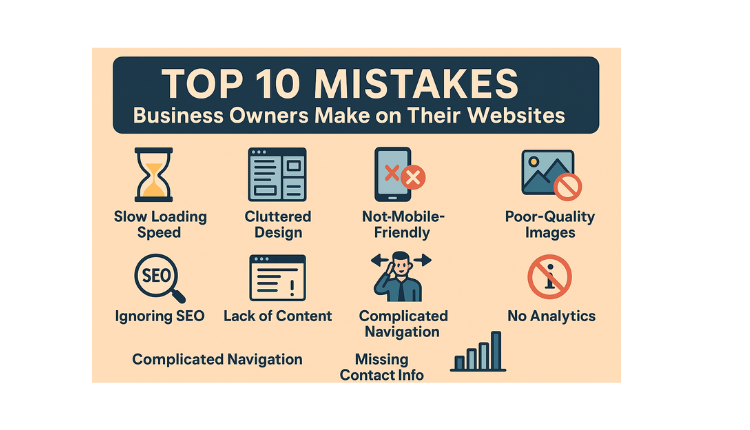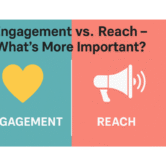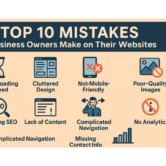
Top 10 Mistakes Business Owners Make on Their Websites – Avoid These Costly Errors Today!
Introduction to Common Website Pitfalls
In today’s digital-first world, your website is often the first impression customers have of your business. It acts as your storefront, your portfolio, and sometimes even your salesperson. Yet, many business owners unknowingly make costly mistakes on their websites that drive away visitors, reduce conversions, and damage credibility.
These website mistakes—ranging from outdated designs to weak SEO—can seem minor but have major consequences. Whether you’re just launching your site or have had one for years, understanding what to avoid can save you time, money, and missed opportunities.“Many businesses lose clients because of confusing layouts. Our Website Services ensure your site is mobile-friendly, clear, and conversion-focused.”
Let’s dive into the top 10 mistakes business owners make on their websites and explore how to fix them.
Mistake 1 – Ignoring Mobile Optimization
More than 60% of website traffic comes from mobile devices. If your site isn’t mobile-friendly, you’re instantly turning away potential customers.
Why It’s a Problem:
- Poor mobile design leads to high bounce rates.
- Google prioritizes mobile-friendly sites in search results.
- Buttons may be too small, or text unreadable on small screens.
Fix It:
- Use a responsive design that adjusts for screen sizes.
- Test your site on different devices.
- Use Google’s Mobile-Friendly Test tool.
Mistake 2 – Poor Website Loading Speed
Speed matters. A slow website can frustrate users and drive them straight to your competitor.
Why It’s a Problem:
- Users expect a site to load in under 3 seconds.
- Slow load times negatively affect SEO.
- It impacts mobile users even more.
Fix It:
- Compress images.
- Use caching tools.
- Choose a reliable hosting provider.
Mistake 3 – Weak or No Call-to-Action (CTA)
A Call-to-Action guides your visitors on what to do next—whether it’s “Buy Now,” “Subscribe,” or “Get a Free Quote.”
Why It’s a Problem:
- Visitors leave without engaging.
- Sales funnel gets broken.
- Missed conversions.
Fix It:
- Place CTAs clearly on every page.
- Use action-oriented language.
- A/B test to see what works best.
Mistake 4 – Outdated Website Design
An old or clunky design can make your business look unprofessional.
Why It’s a Problem:
- Creates distrust.
- Doesn’t reflect modern branding.
- Hurts UX and readability.
Fix It:
- Update your design every 2-3 years.
- Follow modern UI/UX trends.
- Use clean layouts and easy navigation.
Mistake 5 – Lack of Clear Navigation
If users can’t find what they’re looking for, they’ll leave.
Why It’s a Problem:
- Frustrated visitors = lost customers.
- Increases bounce rate.
- Search engines struggle to index your pages.
Fix It:
- Keep menus simple and organized.
- Use breadcrumb navigation.
- Highlight your most important pages.
Mistake 6 – Not Using SEO Best Practices
You can have the best-looking site, but if it’s not optimized for search engines, it won’t bring in traffic.
Why It’s a Problem:
- You miss organic traffic.
- Content doesn’t show up in Google.
- Poor rankings hurt authority.
Fix It:
- Optimize page titles and meta descriptions.
- Use alt tags for images.
- Create keyword-rich, helpful content.
Mistake 7 – Neglecting Website Security
Security builds trust. Visitors need to feel safe providing their info.
Why It’s a Problem:
- Lack of SSL = “Not Secure” warning in browsers.
- Vulnerability to hacks.
- Damages brand reputation.
Fix It:
- Install an SSL certificate.
- Use secure hosting.
- Regularly update plugins and themes.
Mistake 8 – Poor Content Quality or Strategy
Content is king—but only if it’s relevant and helpful.
Why It’s a Problem:
- Visitors bounce if content is thin or outdated.
- Duplicate or generic content hurts SEO.
- No authority or expertise shown.
Fix It:
- Write original, high-quality content.
- Update old posts regularly.
- Add blogs, videos, and case studies.
Mistake 9 – No Conversion Tracking or Analytics
If you’re not measuring, you’re guessing.
Why It’s a Problem:
- You don’t know what’s working.
- You can’t optimize conversions.
- ROI is unclear.
Fix It:
- Set up Google Analytics and Search Console.
- Use goals and events to track performance.
- Analyze heatmaps to see user behavior.
Mistake 10 – Not Updating Website Regularly
A website isn’t “set and forget.”
Why It’s a Problem:
- Broken links or outdated info.
- Security vulnerabilities grow.
- SEO performance drops.
Fix It:
- Update content at least monthly.
- Perform regular site audits.
- Refresh visuals and design periodically.
How to Audit and Fix These Website Mistakes
Here’s a simple checklist to get started:
| Issue | Fix |
| Mobile Unfriendly | Use responsive themes |
| Slow Speed | Optimize images, caching |
| Weak CTA | Add action buttons |
| Outdated Design | Use modern layouts |
| Confusing Navigation | Simplify menus |
| No SEO | Add meta tags, keywords |
| No SSL | Install certificate |
| Thin Content | Add blogs, case studies |
| No Tracking | Use Google Analytics |
| Infrequent Updates | Monthly reviews |
Benefits of an Optimized Business Website
When your website avoids these mistakes:
- More Traffic: SEO brings in organic visitors.
- Higher Engagement: Visitors stay longer and interact more.
- Better Conversions: A smooth user journey leads to more sales.
- Stronger Brand: A modern, secure site builds credibility.
Frequently Asked Questions
- How can I tell if my website is mobile-friendly?
Use Google’s Mobile-Friendly Test tool. It checks layout, fonts, and usability on smaller screens. - Why is website speed so important?
Faster sites keep users engaged, reduce bounce rate, and perform better in search engine rankings. - What makes a good CTA?
It should be clear, action-driven (“Buy Now,” “Get a Quote”), and placed where users naturally look next. - How often should I update my website content?
At least once a month. Blogs, service pages, and product descriptions benefit from regular refreshes. - Can I do SEO myself or do I need an expert?
You can start with basic SEO practices, but for best results, hiring an expert is recommended.
6. Is SSL really necessary for small business websites?
Yes! SSL ensures data privacy and helps build trust. Google also favors HTTPS sites.“Help Me Buddy helps businesses fix website mistakes and turn their sites into client-getting machines. Learn more at helpmebuddy.in.”













